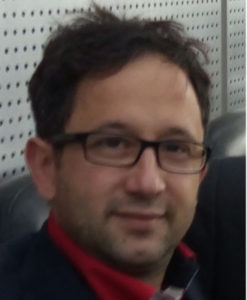 SPINTEC welcome Giovanni Finocchio from University of Messina, Italy. On Wednesday, October 5th at 16:00 he will give us a seminar entitled:
SPINTEC welcome Giovanni Finocchio from University of Messina, Italy. On Wednesday, October 5th at 16:00 he will give us a seminar entitled:
Spintronic devices for microwave technology and probabilistic computing
Place : CEA Bat. 10.05 Room 445 (limited to persons having a CEA Badge)
skype link : https://webconf.cea.fr/ioan-lucian.prejbeanu/C89D5FFJ
if this link does not work see below (*)
Abstract : Spintronic technology, which takes advantage from the simultaneous use of charge and spin of the electron, has recently grown attention because of its success stories, starting from the hard disk read heads to the spin-transfer-torque MRAMs, in solid-state devices. A key building block of spintronic devices is the magnetic tunnel junction (MTJ). The fundamental element of a MTJ is a tri-layer composed by two ferromagnets separated by a thin isolating material. The resistance of this tri-layer depends on the relative orientation of the magnetization vector of each ferromagnet. In general, one of the two is designed to be fixed while the other can be manipulated easily with field, current and/or voltage. Together to the switching, it has been shown that in presence of a dc spin-polarized current it is possible to excited self-oscillation of the magnetization having the so called spin-transfer-torque oscillator while with an ac input it is achieved the diode effect. In this talk we will review the fundamental properties of spintronic devices and their applications as hardware building block in microwave technology and neuromorphic computing, in particular for the realization of neurons and synapses. Depending of the MTJ physical and geometrical parameters, it is possible to reproduce sigmoid and ReLU activation functions (most used so far at software level). we also show a possible use of spintronic diodes to implement analog multiplication, which is a key operation in convolutional neural networks (CNN), introducing the concept of degree of rectification (DOR). We will also discuss antiferromagnetic devices for implementation of synapses and memristive systems for computing applications.
In the last part of the talk, I will review our recent results on Ising machines (IMs) and their potential hardware implementation with spintronic technology focusing on oscillator-based IMs and IMs built with p-bits (probabilistic computing). This computing paradigm is very promising to solve combinatorial optimization problems (COPs), which are a class of mathematical problems that have important applications in a variety of industrial and scientific fields, which span from logistics to geoscience, from water distribution network design to job scheduling. Many of these, such as maximum cut (Max-Cut), maximum Boolean satisfiability (max-SAT) or the travelling salesman problem, are NP- complete or NP-hard, meaning in their worst-case instances they have no polynomial-time solution.
We show how the probabilistic computing can be used to solve max-sat instances (the other problems can be mapped on them) beating state-of-the art solvers having a time-to-solution to 95% at least one order of magnitude smaller.
Biography : Giovanni Finocchio received the Ph.D. degree in advanced technologies in optoelectronic, photonic and micromagnetic modeling from the University of Messina, Italy, in 2006. Since 2010, he has been an Assistant Professor first and Associate professor now with the Department of Mathematical and Computer Sciences, Physical Sciences and Earth Sciences at the University of Messina. He is director of the laboratory PETASPIN (Petascale computing and Spintronics)Messina. His research interests include spintronics, skyrmions, and computing (https://scholar.google.co.uk/citations?user=eKDbn-oAAAAJ&hl=en). In the last 10 years, he served on many technical program committees of international conferences and organized more than 10 international conferences and workshops as Chair, Program Committee Member, orother positions. He is regularly invited at conferences in Magnetism and Spintronics. He is also president of Petaspin association (www.petaspin.com), chair of the IEEE Magnetics Italy chapter, AdCOM member of the IEEE Magnetics society and chair of the TC-16 on Quantum, neuromorphic and unconventional computing of the IEEE Nanotechnology council. Since 2022, he is also associate editor of Physical Review Applied (APS).
(*) IF THE LINK DOES NOT WORK,
try with skype web App : https://webconf.cea.fr/ioan-lucian.prejbeanu/C89D5FFJ?sl=1
or by phone +33 1 69 35 55 10 conf ID : 5909422




